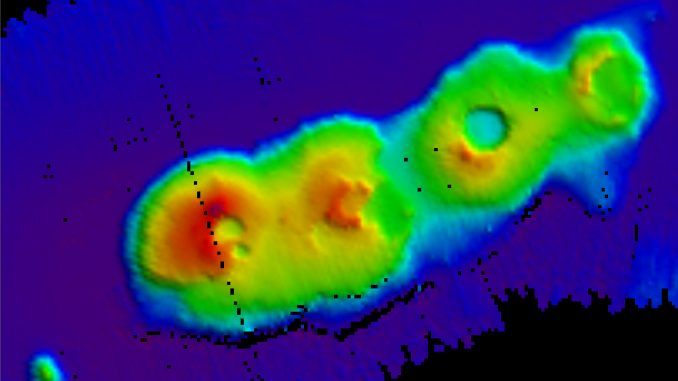
A team of researchers have unexpectedly discovered four huge extinct underwater volcanoes off the coast of Sydney in Australia.
The team from Australia’s national science agency (CSIRO) made the accidental discovery during a search for larval lobster breeding grounds.
The cluster of volcanoes is believed to be around 50 million years old and may hold clues to how Australia separated from New Zealand.

BYPASS THE CENSORS
Sign up to get unfiltered news delivered straight to your inbox.
You can unsubscribe any time. By subscribing you agree to our Terms of Use
Yahoo news report:
The four volcanoes are located about 155 miles (250 kilometers) off the coast of Sydney, the researchers found during the mission, which lasted from June 3 to 18. The scientists immediately recognized them as calderas, a cauldronlike structure that forms after a volcano erupts and collapses into itself, creating a crater. The largest extinct volcano measures about 1 mile (1.5 km) across and towers about 0.4 miles (700 meters) above the seafloor, the researchers said.
The cluster is a large one, measuring about 12 miles (20 km) long and 4 miles (6 km) wide, they added. [Axial Seamount: Images of an Erupting Undersea Volcano]
The discovery will help geoscientists learn more about the geological forces that shaped the region, said Richard Arculus, a professor of marine geology at the Australian National University and an expert on volcanoes.
“They tell us part of the story of how New Zealand and Australia separated around 40 [million to] 80 million years ago, and they’ll now help scientists target future exploration of the seafloor to unlock the secrets of the Earth’s crust,” Arculus said in a statement.
The volcano cluster, which sits about 3 miles (4.9 km) underwater, went unnoticed until now because researchers didn’t have adequate tools to measure and map the deep seafloor, Arculus said.
The sonar on the old research vessel run by Marine National Facility (MNF), a research group funded by the Australian government, only had the ability to map the seafloor to about 1.9 miles (3 km) underwater, he said. A new 308-foot-long (94 m) vessel, named the Investigator, has a greater scope.
“On board the new MNF vessel, Investigator, we have sonar that can map the seafloor to any depth, so all of Australia’s vast ocean territory is now within reach, and that is enormously exciting,” Arculus said.
During the Investigator’s latest mission, researchers were looking for the nursery grounds of lobster larvae while simultaneously carrying out a routine mapping of the seafloor.
“The voyage was enormously successful,” Iain Suthers, a professor of marine biology at the University of New South Wales, said in the statement. “Not only did we discover a cluster of volcanoes on Sydney’s doorstep, we were amazed to find that an eddy off Sydney was a hotspot for lobster larvae at a time of the year when we were not expecting them.”


Be the first to comment